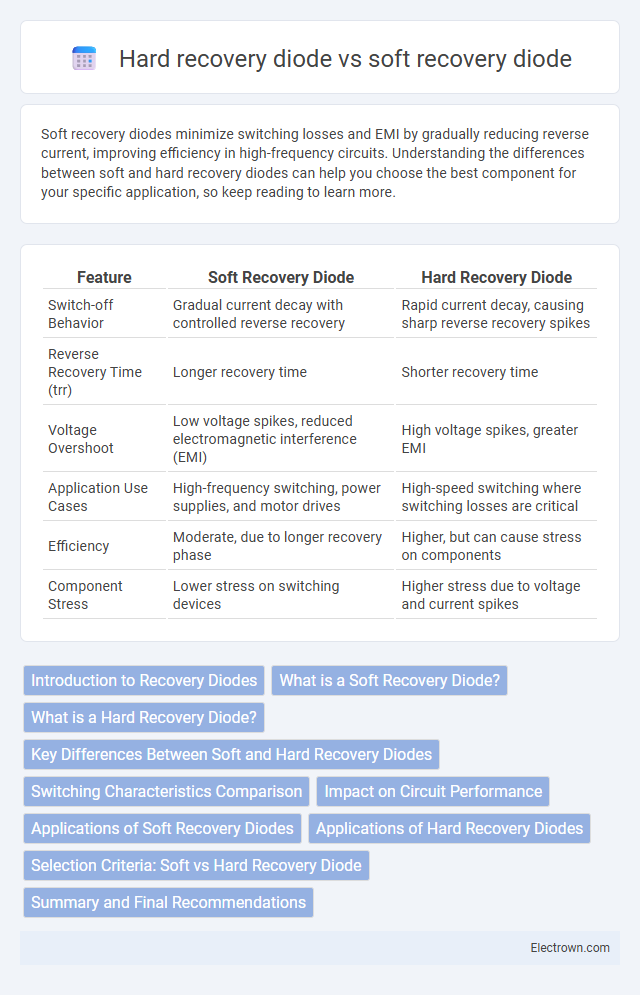Soft recovery diodes minimize switching losses and EMI by gradually reducing reverse current, improving efficiency in high-frequency circuits. Understanding the differences between soft and hard recovery diodes can help you choose the best component for your specific application, so keep reading to learn more.
Table of Comparison
| Feature | Soft Recovery Diode | Hard Recovery Diode |
|---|---|---|
| Switch-off Behavior | Gradual current decay with controlled reverse recovery | Rapid current decay, causing sharp reverse recovery spikes |
| Reverse Recovery Time (trr) | Longer recovery time | Shorter recovery time |
| Voltage Overshoot | Low voltage spikes, reduced electromagnetic interference (EMI) | High voltage spikes, greater EMI |
| Application Use Cases | High-frequency switching, power supplies, and motor drives | High-speed switching where switching losses are critical |
| Efficiency | Moderate, due to longer recovery phase | Higher, but can cause stress on components |
| Component Stress | Lower stress on switching devices | Higher stress due to voltage and current spikes |
Introduction to Recovery Diodes
Recovery diodes are critical components in power electronics designed to manage the transition from conducting to blocking states efficiently. Soft recovery diodes feature a gradual reduction in reverse current, minimizing voltage spikes and electromagnetic interference, making them ideal for high-frequency switching applications. Hard recovery diodes, in contrast, have a rapid current cessation that generates higher voltage overshoot, which can stress circuits but offers faster switching suitable for specific power systems.
What is a Soft Recovery Diode?
A Soft Recovery Diode is designed to minimize voltage spikes and reduce electromagnetic interference by controlling the diode's reverse recovery current more gradually compared to a Hard Recovery Diode. This type of diode ensures smoother switching transitions, which enhances efficiency and reliability in power electronics applications such as inverters and converters. Choosing the right recovery diode can greatly impact Your system's performance by lowering switching losses and improving overall electrical noise characteristics.
What is a Hard Recovery Diode?
A Hard Recovery Diode is a type of diode designed to switch off rapidly, causing a sudden cessation of current flow which can generate significant voltage spikes and electromagnetic interference. This diode exhibits a quick reverse recovery time but with a high reverse recovery current, leading to increased switching losses and potential stress on electronic components. Your choice between hard and soft recovery diodes depends on the application's tolerance for noise, efficiency requirements, and operating frequency.
Key Differences Between Soft and Hard Recovery Diodes
Soft recovery diodes exhibit controlled, gradual decrease in reverse current, minimizing voltage spikes and electromagnetic interference, making them ideal for high-frequency switching applications. Hard recovery diodes, in contrast, have abrupt current cessation resulting in higher voltage overshoot and switching losses, which can cause increased stress on circuit components. The key differences lie in their recovery time characteristics, switching losses, and impact on circuit noise, with soft recovery diodes providing smoother transitions and enhanced reliability in sensitive electronic environments.
Switching Characteristics Comparison
Soft recovery diodes exhibit a gradual decline in reverse current during switching, minimizing voltage spikes and electromagnetic interference, while hard recovery diodes switch off sharply, causing higher transient voltage and increased noise. Your choice between soft and hard recovery diodes significantly impacts switching frequency and efficiency in power electronics applications. Soft recovery diodes are preferred for high-frequency circuits due to their smoother switching characteristics, enhancing overall system performance.
Impact on Circuit Performance
Soft recovery diodes reduce voltage spikes and electromagnetic interference during switching by gradually dissipating stored charge, enhancing overall circuit reliability and efficiency. Hard recovery diodes cause abrupt current changes, leading to increased switching losses and potential stress on circuit components. Your choice of diode directly affects switching speed, power loss, and electromagnetic compatibility in high-frequency applications.
Applications of Soft Recovery Diodes
Soft recovery diodes are primarily used in applications where minimizing electromagnetic interference (EMI) and reducing voltage overshoot during switching are critical, such as in high-frequency power supplies, motor drives, and renewable energy inverters. These diodes enable smoother turn-off transitions, enhancing efficiency and protecting sensitive electronic components in devices like switch-mode power supplies (SMPS) and uninterruptible power supplies (UPS). Their ability to reduce switching losses and noise makes them ideal for power electronics in consumer electronics and industrial automation systems.
Applications of Hard Recovery Diodes
Hard recovery diodes are primarily used in applications where fast switching and minimal recovery time are critical, such as in high-frequency power converters, inductive load switching, and snubber circuits. Their ability to withstand high voltage and current spikes makes them ideal for rectifiers in motor drives, welding equipment, and uninterruptible power supplies (UPS). When choosing components for these demanding environments, your system benefits from the robustness and efficiency of hard recovery diodes to handle rapid voltage transitions effectively.
Selection Criteria: Soft vs Hard Recovery Diode
Selection criteria for soft recovery diodes prioritize reduced electromagnetic interference (EMI) and lower voltage overshoot during turn-off, making them ideal for high-frequency switching applications such as motor drives and power supplies. Hard recovery diodes are chosen for their fast switching speed and robustness in circuits requiring minimal recovery time, often found in low-frequency or high-current environments. Evaluating parameters like reverse recovery time (trr), reverse recovery charge (Qrr), and energy dissipation guides the decision between soft and hard recovery diodes based on efficiency and noise constraints.
Summary and Final Recommendations
Soft recovery diodes exhibit lower voltage and current spikes during switching, reducing electromagnetic interference and improving efficiency in high-frequency circuits, while hard recovery diodes provide faster recovery times suitable for high-speed applications but generate higher switching noise. Your choice depends on balancing noise sensitivity with switching speed demands; soft recovery diodes are ideal for applications prioritizing low noise and reduced stress on components. For power electronics requiring minimal EMI and extended device longevity, soft recovery diodes are generally recommended, whereas hard recovery diodes are better suited for ultra-fast switching requirements.
Soft recovery diode vs hard recovery diode Infographic

 electrown.com
electrown.com